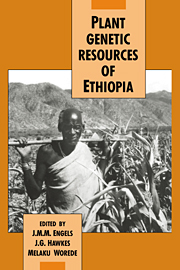Book contents
- Frontmatter
- Contents
- Contributors
- List of acronyms
- Preface
- Part I General introduction
- Part II The Ethiopian centre of diversity
- Part III Germplasm collection and conservation in Ethiopia
- Part IV Evaluation and utilization of Ethiopian genetic resources
- 18 Germplasm evaluation with special reference to the role of taxonomy in genebanks
- 19 Crop germplasm multiplication, characterization, evaluation and utilization at PGRC/E
- 20 Evaluation methods and utilization of germplasm of annual crop species
- 21 Evaluation and utilization of Ethiopian forage species
- 22 Improvement of indigenous durum wheat landraces in Ethiopia
- 23 Use of germplasm resources in breeding wheat for disease resistance
- 24 Indigenous barley germplasm in the Ethiopian breeding programme
- 25 The role of Ethiopian sorghum germplasm resources in the national breeding programme
- 26 Germplasm evaluation and breeding work on teff (Eragrostis tef) in Ethiopia
- 27 Pulse crops of Ethiopia: genetic resources and their utilization
- 28 Oil crop germplasm: a vital resource for the plant breeder
- 29 Significance of Ethiopian coffee genetic resources to coffee improvement
- 30 Use of Ethiopian germplasm in national and international programmes
- Index
29 - Significance of Ethiopian coffee genetic resources to coffee improvement
Published online by Cambridge University Press: 30 October 2009
- Frontmatter
- Contents
- Contributors
- List of acronyms
- Preface
- Part I General introduction
- Part II The Ethiopian centre of diversity
- Part III Germplasm collection and conservation in Ethiopia
- Part IV Evaluation and utilization of Ethiopian genetic resources
- 18 Germplasm evaluation with special reference to the role of taxonomy in genebanks
- 19 Crop germplasm multiplication, characterization, evaluation and utilization at PGRC/E
- 20 Evaluation methods and utilization of germplasm of annual crop species
- 21 Evaluation and utilization of Ethiopian forage species
- 22 Improvement of indigenous durum wheat landraces in Ethiopia
- 23 Use of germplasm resources in breeding wheat for disease resistance
- 24 Indigenous barley germplasm in the Ethiopian breeding programme
- 25 The role of Ethiopian sorghum germplasm resources in the national breeding programme
- 26 Germplasm evaluation and breeding work on teff (Eragrostis tef) in Ethiopia
- 27 Pulse crops of Ethiopia: genetic resources and their utilization
- 28 Oil crop germplasm: a vital resource for the plant breeder
- 29 Significance of Ethiopian coffee genetic resources to coffee improvement
- 30 Use of Ethiopian germplasm in national and international programmes
- Index
Summary
Introduction
Among the economic species of coffee grown in more than 50 countries in different parts of the world, Coffea arabica L. is the only tetraploid species of the genus. It contributes over 80 per cent of the world's coffee production. In many scientific reports Ethiopia is considered to be the centre of origin and diversification of coffee (Sylvain, 1958; Fernie, 1966; Food and Agriculture Organization, 1968; Carvalho et al., 1969; Ameha, 1980; Rodrigues, 1981; Worede, 1982; Watkins, 1985). The question of whether the south-west mountain moist evergreen forest, the farmer's field or the low altitude river banks is the primary habitat is not discussed here, although the issue is of primary interest to geneticists and breeders, for conservation purposes and in the search for primitive genes in the wild progenitors.
Arabica coffee is an evergreen shrub of variable size. The tree grows up to 14 m in height and about 2 m in width under forest strata and up to 6 m in height and about 12 m in width in canopy under farmers' holdings (a tree this size was observed in Wanago near Dilla in Sidamo administrative region). Naturally, it has a dominant central orthotropic stem and horizontally growing plagiotropic branches with pairs of secondary, tertiary, etc. branches originating from preceding branches in the hierarchy. The leaves are borne in opposite pairs along the side of the branches. The flowers emerge as inflorescences on all forms of lateral branches in each leaf axil of the nodes.
- Type
- Chapter
- Information
- Plant Genetic Resources of Ethiopia , pp. 354 - 359Publisher: Cambridge University PressPrint publication year: 1991
- 2
- Cited by



